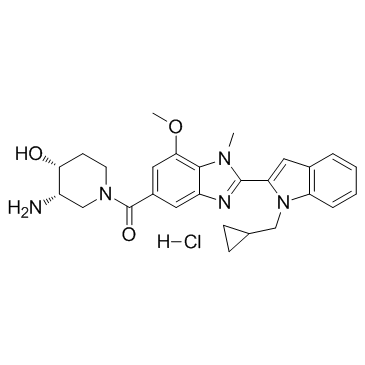| Description: |
GSK484 is a peptidylarginine deiminase 4 (PAD4) inhibitor. GSK484 demonstrates high affinity binding to PAD4 with IC50s of 50 nM in the absence of Calcium. In the presence of 2 mM Calcium, notably lower potency (250 nM) is observed. |
| Target: |
IC50: 50 nM (PAD4, in the absence of Calcium), 250 nM (PAD4, in the presence of 2 mM Calcium)[1] |
| In Vivo: |
To address whether PAD4 inhibition can suppress cancer-associated kidney injury, MMTV-PyMT mice are treated with the PAD4 inhibitor GSK484 at 4 mg/kg daily for one week. This dose suppress the elevated number of neutrophils undergoing NETosis in peripheral blood in mice with cancer. In parallel, the total protein level in urine from MMTV-PyMT mice is significantly reduced compared with untreated tumor-bearing mice, further supporting an improved functional status of the kidneys after GSK484 treatment. Administration of GSK484 at a dose of 4 mg/kg daily during one week reverts signs of kidney dysfunction in tumor-bearing mice to the same extent as DNase I treatment, without any detectable signs of toxicity[2]. |
| In Vitro: |
GSK484 demonstrates high affinity binding to the low-calcium form of PAD4 with IC50s of 50 nM and 250 nM in the absence of Calcium (0 mM) and Calcium (2 mM), respectively. GSK484 also inhibits PAD4 citrullination (at 0.2 mM Calcium) of benzoyl-arginine ethyl ester (BAEE) substrate in a concentration-dependent manner, as detected using an NH3 release assay[1]. |
| Kinase Assay: |
PAD4 is serially diluted in the presence of 10 nM GSK215 in assay buffer (100 mM HEPES, pH 8, 50 mM NaCl, 5% glycerol, 1 mM CHAPS, 1 mM DTT) at varying concentrations of calcium (0, 0.2, 2 and 10 mM). Following incubation for 50 min, apparent Kds for each calcium concentration are determined using a single site saturation curve. For IC50 determination, test compounds (e.g., GSK484) are serially diluted in DMSO (1% final assay concentration) and tested at the same range of calcium concentrations in the presence of PAD4 (at the calculated Kd for each calcium condition) and 10 nM GSK215 in the same assay buffer and volume. Reactions are incubated for 50 min after which IC50 values are calculated using a four-parameter logistic equation[1]. |
| Cell Assay: |
HEK293 cells stably expressing N-terminal FLAG-tagged PAD1, PAD2, PAD3 or PAD4 are engineered by retroviral transduction. Cells are grown in 15 cm diameter plates to subconfluency in DMEM supplemented with 10% Foetal Bovine Serum, harvested by centrifugation and washed once in PBS/2 mM EGTA. Cells are lysed in 50 mM Tris-Cl, pH 7.4, 1.5 mM MgCl2, 5% glycerol, 150 mM NaCl, 25 mM NaF, 1 mM Na3VO4, 0.4% NP40, 1 mM DTT with protease inhibitors. Lysates are pre-incubated for 20 min at 4°C with DMSO alone (2%), 100 µM of GSK199, GSK484, GSK106 or 200 µM Cl-amidine. Citrullination reactions are performed for 30 min at 37°C in the presence of 2 mM calcium. Extracts are loaded on to gels, proteins separated by SDS-PAGE and transferred to PVDF membranes. Citrullinated proteins are then chemically modified and detected using anti-modified citrulline antibody. FLAG-PAD constructs are detected using anti-FLAG antibody[1]. |
| Animal Administration: |
Mice[2] The study includes two transgenic mouse models, the MMTV-PyMT mouse model for mammary carcinoma (FVB/n background) and the RIP1-Tag2 mouse model for pancreatic neuroendocrine carcinoma (C57BL/6 background). Mice are treated daily by intra-peritoneal injections of the PAD4 inhibitor GSK484 (4 mg/kg). GSK484 is dissolved in 99.9% ethanol at a concentration of 25 mg/mL to generate a stock solution and further diluted 1:50 in 0.9% NaCl shortly before injection of 200 μL/mouse[2]. |
| References: |
[1]. Lewis HD, et al. Inhibition of PAD4 activity is sufficient to disrupt mouse and human NET formation. Nat Chem Biol. 2015 Mar;11(3):189-91.
[2]. Cedervall J, et al. Pharmacological targeting of peptidylarginine deiminase 4 prevents cancer-associated kidney injury in mice. Oncoimmunology. 2017 Apr 20;6(8):e1320009. |

 DC Chemicals' products qualify for U.S. tariff exemptions. We guarantee no price increases due to customs duties and maintain stable supply, continuing to deliver reliable research solutions to our American clients.
DC Chemicals' products qualify for U.S. tariff exemptions. We guarantee no price increases due to customs duties and maintain stable supply, continuing to deliver reliable research solutions to our American clients.





















